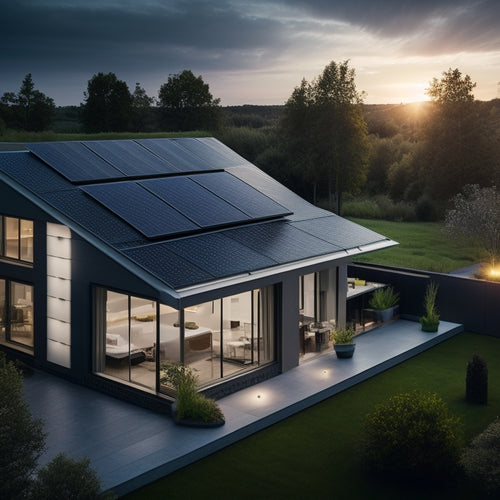
Solar Panels
Share
You're considering utilizing the power of solar energy by installing solar panels, a clean and renewable source of energy that can greatly reduce your reliance on fossil fuels. By capturing free renewable energy, you'll not only lower your electricity bills but also increase your property value. With a well-designed thermal system, you can guarantee peak energy efficiency. Before installation, assess your roof space to determine the ideal solar panel capacity. By choosing the right panel size and orientation, you can maximize your energy output. Now that you're ready to take the first step, investigate the complexities of solar panel technology to optimize your energy savings.
The Essentials
- Solar panels harness sunlight to generate electricity, providing a clean and renewable energy source.
- Properly installed and maintained solar panels can increase property value and lead to significant cost savings.
- Regular cleaning and maintenance can increase energy output by 2-5%, while optimal system sizing can enhance energy savings by 10-20%.
- Effective heat management techniques, such as thermal insulation and cooling, are essential to prevent overheating and reduce efficiency loss.
- Government incentives and financing options make solar energy more accessible, driving consumer adoption of solar energy solutions.
Capture Free Renewable Energy
You can utilize the natural power source of sunlight to generate electricity, reducing your reliance on fossil fuels and lowering your carbon footprint.
By investing in solar panels, you can break free from reliance on the grid and reduce your electricity bills, allowing you to reap significant cost savings while taking control of your energy needs.
By installing solar panels, you'll maximize energy savings and minimize your energy bills.
As you capture free renewable energy, you'll also increase your property's value and contribute to a sustainable future.
Harness Natural Power Source
How can we reduce our reliance on fossil fuels and mitigate the environmental impact of our energy consumption? One effective way is to utilize natural power sources like solar energy.
By installing solar panels, you can tap into the abundant sunlight available to generate electricity. This clean and renewable energy source reduces your carbon footprint, contributing to a more sustainable living.
With professional panel installations, homeowners and businesses can maneuver the complex installation process and guarantee quality workmanship and long-term system efficiency reliable solar installation.
Solar panels convert sunlight into electrical energy through photovoltaic cells. These cells are made from semiconducting materials that release electrons when exposed to sunlight, generating an electric current.
The panels are designed to maximize energy production, considering factors like panel angle, orientation, and shading.
Maximize Energy Savings
Enhancing solar panel performance is crucial to maximize energy savings and capture free renewable energy. You want to verify your solar panels are working efficiently to reduce your reliance on the grid and lower your energy bills. By maximizing energy savings, you can enjoy the freedom of generating your own clean energy and reducing your carbon footprint.
To achieve ideal performance, consider the following factors:
| Factor | Description | Impact on Energy Savings |
|---|---|---|
| Panel Angle | Adjusting panel angle to match seasonal sun patterns | 5-10% increase in energy output |
| Shading | Minimizing shading from trees, buildings, or other obstructions | 10-20% increase in energy output |
| Inverter Efficiency | Upgrading to high-efficiency inverters | 5-10% increase in energy output |
| Maintenance | Regular cleaning and maintenance to prevent energy loss | 2-5% increase in energy output |
| System Size | Installing a system that matches your energy needs | 10-20% increase in energy savings |
Zero Energy Bill Guarantee
You'll likely want a guarantee that your solar panel system will save you money on your energy bills, especially considering the rising cost of electricity and the benefits of renewable energy solutions residential solar panel cost.
In addition, investing in solar panels can also contribute to environment conservation.
That's where an Energy Savings Guarantee comes in, promising a specific amount of savings over a set period.
With a Zero Bill Promise, some providers even guarantee that your energy bills will be zero or close to zero, giving you added peace of mind.
Energy Savings Guarantee
Switching to solar energy can bring a considerable shift in your energy expenses, and that's where the Energy Savings Guarantee comes in. This guarantee guarantees that you'll save a considerable amount on your energy bills, providing you with a sense of financial freedom.
With the Energy Savings Guarantee, you can expect a reduction in your energy expenses, allowing you to allocate your resources more efficiently. The Energy Savings Guarantee is made possible by the innovative technology advancements in the solar panel industry.
The installation process is designed to maximize energy production, and with proper maintenance tips, you can guarantee peak performance. Additionally, the environmental impact of solar energy is markedly lower compared to traditional energy sources, making it an attractive option for those seeking a more sustainable lifestyle.
Government incentives and financing options are available to support your shift to solar energy, making it more accessible than ever. By investing in solar panels, you'll not only benefit from long-term energy savings but also contribute to a cleaner environment.
With residential solutions and commercial applications available, you can achieve energy independence and enjoy the freedom that comes with it.
Zero Bill Promise
Taking your energy savings to the next level, the Zero Bill Promise offers a guarantee that you'll pay nothing on your energy bills. This means you'll enjoy complete energy independence, no longer beholden to your utility company's rates and whims.
With the Zero Bill Promise, you're guaranteed that your solar panels will generate enough electricity to cover your energy needs, leaving you with a zero balance on your energy bills.
To achieve this level of energy independence, our team of experts will carefully assess your energy usage and design a solar panel system customized to your specific needs.
We'll also make sure that you're taking full advantage of available solar incentives, maximizing your savings and minimizing your upfront costs.
With the Zero Bill Promise, you'll enjoy the freedom and security that comes with generating your own clean, renewable energy.
Say goodbye to rising energy bills and hello to a brighter, more sustainable future.
Efficient Heat Dissipation System
You understand that solar panels can overheat, reducing their efficiency and lifespan.
High-efficiency photovoltaics renewable energy solutions are particularly susceptible to temperature fluctuations, which can greatly impact their performance.
To mitigate this, you'll need to implement effective heat management techniques and ideal thermal design in your efficient heat dissipation system.
Heat Management Techniques
How does temperature affect solar panel efficiency? As you install solar panels, you need to evaluate the impact of temperature on their performance. High temperatures can greatly reduce their energy efficiency. That's why heat management techniques are essential to maintain ideal performance.
You can implement thermal insulation to minimize heat absorption. Proper panel orientation is also important, as it helps reduce direct sunlight exposure and heat buildup. Additionally, applying heat reflection materials can reflect sunlight and reduce heat absorption.
Cooling techniques, such as passive or active cooling systems, can also help regulate temperatures. Effective temperature regulation is fundamental, especially in hot climates. It not only improves energy efficiency but also reduces the climate impact of your solar panels.
Regular system maintenance and performance monitoring are essential to guarantee your solar panels operate within ideal temperatures. By incorporating these heat management techniques, you can enjoy maximum energy efficiency and freedom from reliance on fossil fuels.
Optimal Thermal Design
Implementing heat management techniques is only half the battle; a well-designed thermal system is necessary to guarantee peak energy efficiency.
When designing your solar panel system, you'll want to prioritize ideal thermal design to maximize energy output. This means incorporating thermal insulation to minimize heat transfer and reduce energy loss. By doing so, you can enhance your solar efficiency and increase energy storage capacity.
A well-designed thermal system also helps mitigate the climate impact of your solar panels by reducing the risk of overheating. This, in turn, extends system longevity and reduces maintenance needs.
Proper installation techniques, such as ideal panel orientation, are also vital in ensuring efficient heat dissipation. Regular performance monitoring and cost analysis will help you identify areas for improvement and refine your system's performance.
Check Your Roof Size
You'll need to assess your roof's space availability to determine how many solar panels can fit.
Take precise measurements of your roof's size to calculate its surface area, taking into account factors like obstructions, vents, and skylights.
Since an energy audit can help identify areas of energy inefficiency, it's crucial to evaluate these factors when determining the ideal solar panel configuration.
Accurate roof size measurements will help you determine the ideal solar panel configuration for your installation.
Roof Space Availability
Since your solar panel system's size is directly tied to the amount of energy it can produce, evaluating your roof's available space is a vital step in determining how many panels you can install.
You'll need to take into account roof type considerations, as certain types like skylights, vents, or chimneys may reduce the available space. Additionally, you'll want to assess the shading impact from surrounding trees, buildings, or other obstructions that may cast shadows on your roof.
When evaluating your roof's space, remember that solar panels typically come in standard sizes, ranging from 250 to 400 watts.
You'll need to calculate the total available space to determine how many panels can fit comfortably. Keep in mind that leaving some space between panels is significant for airflow and maintenance. A general rule of thumb is to leave about 1-2 inches of clearance between panels.
Roof Size Measurements
Measure your roof's dimensions to determine the available space for solar panels. This step is essential in evaluating the feasibility of a solar panel installation. You'll need to calculate the length, width, and total square footage of your roof. Consider any obstacles like skylights, vents, or chimneys that may affect the installation.
| Roof Dimension | Measurement |
|---|---|
| Length | Measure from the ridge (peak) to the eave (edge) |
| Width | Measure from one eave to the other, perpendicular to the length |
| Total Square Footage | Calculate by multiplying the length and width |
| Obstacles | Identify and measure any skylights, vents, or chimneys |
When reflecting on roof size measurements, keep in mind installation considerations like panel orientation, spacing, and layout. Confirm you have sufficient space to accommodate the required number of panels, considering their size and efficiency. Accurate roof dimensions will help you determine the ideal solar panel system for your home, allowing you to maximize energy production and achieve energy independence.
Higher Energy Conversion Rate
You're likely looking for solar panels that can convert sunlight into electricity with maximum efficiency.
That's where advanced energy harvesting technologies come in, allowing you to generate more power from the same amount of sunlight.
With efficient energy harvesting tech, you can greatly enhance your solar panel's energy conversion rate.
Efficient Energy Harvesting Tech
Three decades of research and development have yielded significant advancements in solar panel technology, particularly in efficient energy harvesting.
You're now able to reap the benefits of higher energy conversion rates, thanks to innovative materials and designs. These advancements have led to improved solar efficiency, enabling you to generate more power from the same amount of sunlight. This energy innovation not only reduces your reliance on fossil fuels but also minimizes your environmental impact.
When integrating solar panels into the grid, you'll appreciate the streamlined installation process and favorable cost analysis.
With minimal maintenance requirements, you can enjoy a hassle-free experience. As technology advancements continue, you can expect even more efficient energy harvesting solutions. Policy incentives are already driving consumer adoption, making solar energy a more accessible and affordable option.
Frequently Asked Questions
How Long Does It Take to Install a Solar Panel System?
You're wondering how long it takes to complete an installation. Typically, the installation timeline spans several weeks, with the actual installation process taking around 1-3 days, depending on the system's complexity and your roof's accessibility.
Can I Install Solar Panels on a Rented Property?
Are you stuck between a rock and a hard place, wondering if you can make eco-friendly moves in a rented space? You're in luck! As a renter, you have rights, and installation options exist, allowing you to utilize the sun's power, even without owning the property.
Are Solar Panels Affected by Weather Conditions Like Hail?
You're wondering if harsh weather conditions, like hail, impact energy-harvesting systems. Good news: modern designs boast hail resistance and weather durability, ensuring your independence from the grid isn't compromised by Mother Nature's fury.
Can I Use Solar Panels to Charge My Electric Vehicle?
You're considering charging your electric vehicle (EV) sustainably; solar charging is a great option. With a solar-powered EV charging station, you can utilize renewable energy, reducing your carbon footprint and enjoying EV benefits like lower operating costs and independence from fossil fuels.
Do Solar Panels Require Regular Maintenance?
Ah, you think you're off the hook, don't you? Newsflash: even the most liberated of energy enthusiasts need to get their hands dirty. Regular maintenance is key to maximizing solar panel efficiency, lest you want to fork out extra maintenance costs.
Final Thoughts
As you utilize the power of solar panels, imagine a wallet overflowing with savings, like a treasure chest filled to the brim. With a zero energy bill guarantee, efficient heat dissipation system, and higher energy conversion rate, you'll be raking in the benefits. Before you know it, your roof will be generating free renewable energy, and you'll be reaping the rewards. So, check your roof size and get ready to soak up the sun's rays - your wallet will thank you!
Related Posts
-

Why Outdoor Solar Lighting Systems Are Sustainable
Outdoor solar lighting systems are sustainable because they utilize renewable energy, drastically reducing your carbo...
-

Designing a Green Roof for Maximum Energy Efficiency
Designing a green roof for maximum energy efficiency involves several key strategies. Start by selecting native, drou...
-

Home Solar Battery
You're opting for a home solar battery that allows you to utilize the power of the sun during the day and use it at n...


